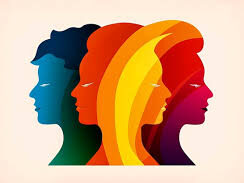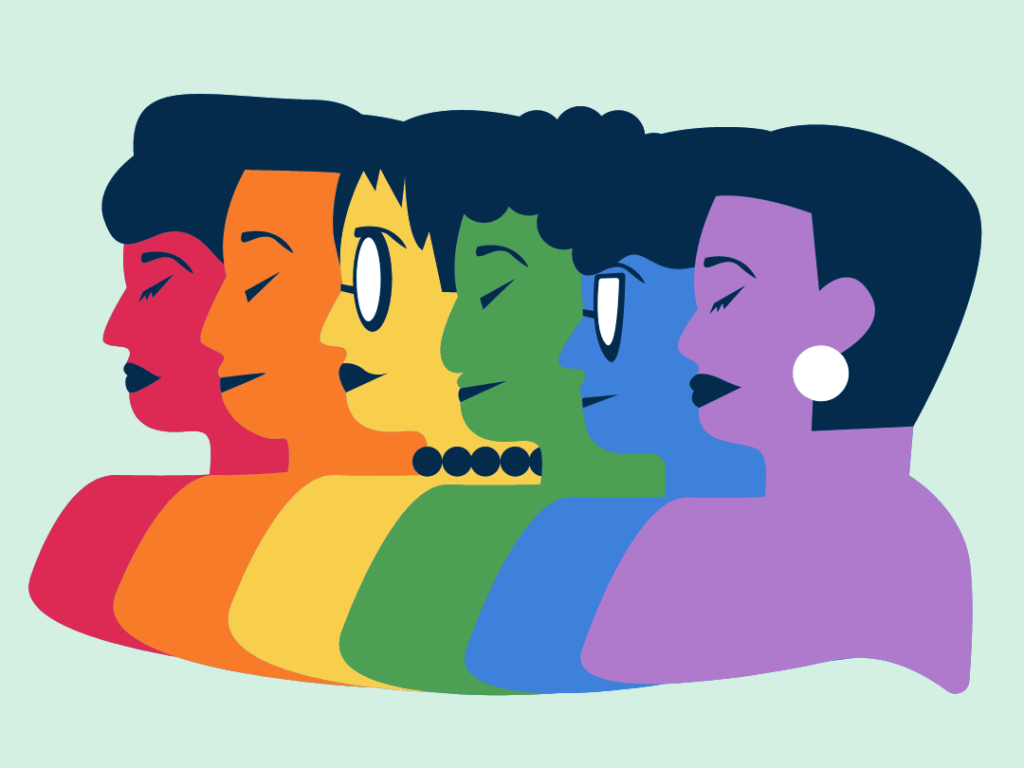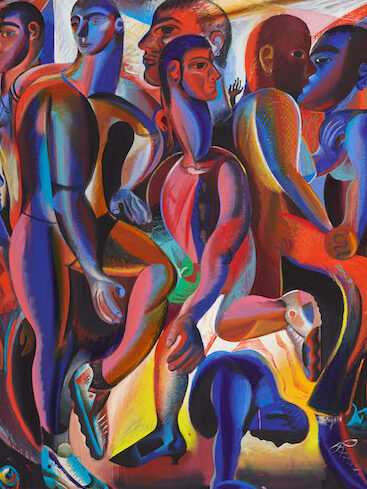
Identifying Identities
What is “Identity”:
“The definition of who we are is complex and multifaceted, given our multiple and diverging roles in social groups membership.”
Self and Identity. Psychology Press, Taylor & Francis, 2023.
Identity is a complex term that can have different interpretations as it can be approached from various perspectives. For the most part, it refers to the distinct characteristics, qualities, beliefs, and experiences that make an individual or group unique and recognizable. There are different ways people do this, for example, personal identity refers to unique ways in which individuals define themselves – what people believe makes them who they are. Subjectivity is an internal identity based on religion and beliefs. Identification is the label that people apply to themselves and others such as gender, sexuality, class and nationality. Social Solidarity is the way people come together to form political movements or groups based on shared identities.
Identity serves multiple functions providing meaning, direction and a sense of control. It fosters internal harmony and serves as a behavioral guide that lets individuals orient themselves towards groups of people – influencing an individual’s capacity to adapt to life. This ultimately gives them a sense of self and allows them to create goals and create progress towards their future.
People have different opinions on how to define identity, some prefer open-ended definitions to allow flexibility and inclusivity but risk broad interpretations. In Boeker’s John Locke: Identity, Persons, and Personal Identity, John Locke critiques the limitation of the term. Philosophers and psychologists try to find universal truths, anthropologists want epic definitions and social theorists view identity as an ever changing dynamic. Overall it is a complex and multifaceted concept shaped by various factors such as culture, ethnicity, gender sexuality, nationality and personal experiences.
History/Background:

As explored in Griffiths’ Identity, the concept of identity has a long history in Western philosophy that goes back to around the 17th Century. The term was brought up in debates with Hegel, Freud, and Karl Marx, where they explored the self and discussed the nature around the self.
The term identity has a shorter history – it was introduced in the mid 20th Century, as a result of psychologists. Freud popularized the concept of identity through psychoanalytical discussion on identification and the incoherence of the self. The term “identity” is also strongly associated with self concept, self image, self esteem, intersectionality and individuality.
Most people use this term in order to describe themselves and explore questions about who they are, how they define themselves, and how they relate to others and the world around them. In Self and Identity, it is commonly referred to people’s sense of who they are as individuals and members of social groups – how others may perceive and label a person. Ideas are developed about identities through interactions with family, friends, school, social media, and other people in general. These interactions shaping one’s identity are very subconscious as we don’t remember learning them.
When describing identity in Social Identities, one person might choose to emphasize their family, religion and interest. A different person might mention their race, neighborhood, and job as important parts of who they are. Especially as this source discusses how people create belonging through intercultural interactions as they attempt to create identities for themselves. An identity is simply a label a person applies on themselves. It can give a person a sense of inclusion to where they fit in the world. It can also give others reasons to do things to us. For example, using identity as the basis of hierarchies of status, respect and structures of power.
Examples
LGBTQ+ Identity:

LGBTQ+ identity represents the diverse sexual orientations and gender identities within the lesbian, gay, bisexual, transgender, queer, and other non-heterosexual and non-cisgender communities – the term “LGBTQ+” is an umbrella term to describe these. People that chose to identify under this term allow the identity to shape themselves. In Hagai’s Queer Theory and Psychology: Intersectionality and Identity, it shows whether it may be the group of friends they will hangout with or the work environment they have, an identity ultimately gives them a sense of self and allows them to create goals and create progress towards their future.
Digital Identity:
Digital identity refers to the online persona of an individual, including their activities, interactions, and information shared on digital platforms or social media. At times it raises concerns about privacy and cybersecurity in the “digital age”, but because of the popularity of social media some people chose to ignore this. Digital identities are employed for a wide range of purposes and benefits, ranging from the authentication and authorization of users for access to information and resources. However, the way a person chooses to identify themselves online does not determine who they are in real life. Managing digital identity, privacy, and security is a critical skill in the digital age, and it involves learning to effectively manage one or more digital identities.

Professional Identity:

A person’s professional identity relates to how individuals perceive themselves within their occupational roles, including their skills, expertise, and ethical standards. It influences career choices, professional development, and workplace interactions. How does someone identify in a professional setting? A person may prioritize their position, or title when describing their identity.It is an essential aspect of career development and can help individuals navigate the workplace, develop their career goals, and identify the personal values that are most important to them. In Neofotistos’ Identity Politics, it is explained how building and refining professional identity can help individuals stand out to employers and achieve their career goals. A professional identity crisis can occur when individuals lose their sense of self in their work or career and don’t know how to explain who they are anymore. Reframing, naming, and owning professional identity can help individuals regain their sense of self-worth, self-confidence, inner peace, and self-concept so that they can attract the right opportunities and achieve their career goals.
Significance

Understanding and respecting diverse identities are crucial for promoting inclusivity, equality, and social harmony. Acknowledging and celebrating different identities contribute to a more tolerant and accepting society where individuals can express themselves authentically without fear of discrimination or prejudice. Inclusive environments, whether in schools, workplaces, or communities, are vital for social cohesion and individual well-being. Understanding one’s own identity also is essential to personal development. It allows a person to take pride in their background, culture, gender, ethnicity or anything else a person can choose to identify with.
In different cultures, the term “identity” may be defined and experienced differently. For example, in some cultures, identity may be more closely tied to family or community, while in others, it may be more individualistic. Inclusive environments, whether in schools, workplaces, or communities, are very important. It also gives a voice to minorities or those who have been historically oppressed, allowing them to advocate for their rights and challenge societal inequalities.
Similarly, identity is often related to social injustices. Recognizing the identities of marginalized or disadvantaged groups is crucial in addressing systemic inequalities and advocating for policies and practices that promote fairness and justice. Giving each individual in these groups the opportunity to be heard and helped. In the same way, Neofotistos’ Identity Politics mentions how government officials and policymakers must understand the various identities of the community they serve because it helps them create inclusive policies that address the unique needs and challenges faced by specific groups making sure they have access to resources and opportunities.
In this diverse world, understanding identities is crucial to communication between individuals. It allows people to show respect to those who are different and the same. Overall, it is important to the world as it recognizes and validates the identities of any individual or community and ultimately creates unity.
Citations:
Boeker, Ruth. John Locke: Identity, Persons, and Personal Identity. Oxford University Press, 2023.
Forstie, Clare. Sexual Identity. Oxford University Press, 2023.
Neofotistos, Vasiliki P.. Identity Politics. Oxford University Press, 2023.
Hagai, Ella Ben. Queer Theory and Psychology: Intersectionality and Identity. Springer, 2022.
Griffiths, Melanie B. E. Identity. Oxford University Press, 2015
Self and Identity. Psychology Press, Taylor & Francis, 2023.
Social Identities. Carfax International Publishers, 2023.
